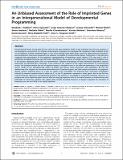| dc.contributor.author | Radford, Elizabeth J. | |
| dc.contributor.author | Jimenez-Chillaron, Josep | |
| dc.contributor.author | Schroeder, Joshua | |
| dc.contributor.author | Molla, Michael | |
| dc.contributor.author | Andrews, Simon | |
| dc.contributor.author | Didier, Nathalie | |
| dc.contributor.author | Charalambous, Marika | |
| dc.contributor.author | McEwen, Kirsten | |
| dc.contributor.author | Marazzi, Giovanna | |
| dc.contributor.author | Sassoon, David | |
| dc.contributor.author | Ferguson-Smith, Anne C. | |
| dc.contributor.author | Isganaitis, Elvira | |
| dc.contributor.author | Patti, Mary-Elizabeth | |
| dc.date.accessioned | 2012-12-21T18:59:48Z | |
| dc.date.issued | 2012 | |
| dc.identifier.citation | Radford, Elizabeth J., Elvira Isganaitis, Josep Jimenez-Chillaron, Joshua Schroeder, Michael Molla, Simon Andrews, Nathalie Didier, et al. 2012. An unbiased assessment of the role of imprinted genes in an intergenerational model of developmental programming. PLoS Genetics 8(4): e1002605. | en_US |
| dc.identifier.issn | 1553-7390 | en_US |
| dc.identifier.uri | http://nrs.harvard.edu/urn-3:HUL.InstRepos:10121113 | |
| dc.description.abstract | Environmental factors during early life are critical for the later metabolic health of the individual and of future progeny. In our obesogenic environment, it is of great socioeconomic importance to investigate the mechanisms that contribute to the risk of metabolic ill health. Imprinted genes, a class of functionally mono-allelic genes critical for early growth and metabolic axis development, have been proposed to be uniquely susceptible to environmental change. Furthermore, it has also been suggested that perturbation of the epigenetic reprogramming of imprinting control regions (ICRs) may play a role in phenotypic heritability following early life insults. Alternatively, the presence of multiple layers of epigenetic regulation may in fact protect imprinted genes from such perturbation. Unbiased investigation of these alternative hypotheses requires assessment of imprinted gene expression in the context of the response of the whole transcriptome to environmental assault. We therefore analyse the role of imprinted genes in multiple tissues in two affected generations of an established murine model of the developmental origins of health and disease using microarrays and quantitative RT–PCR. We demonstrate that, despite the functional mono-allelicism of imprinted genes and their unique mechanisms of epigenetic dosage control, imprinted genes as a class are neither more susceptible nor protected from expression perturbation induced by maternal undernutrition in either the F1 or the F2 generation compared to other genes. Nor do we find any evidence that the epigenetic reprogramming of ICRs in the germline is susceptible to nutritional restriction. However, we propose that those imprinted genes that are affected may play important roles in the foetal response to undernutrition and potentially its long-term sequelae. We suggest that recently described instances of dosage regulation by relaxation of imprinting are rare and likely to be highly regulated. | en_US |
| dc.language.iso | en_US | en_US |
| dc.publisher | Public Library of Science | en_US |
| dc.relation.isversionof | doi:10.1371/journal.pgen.1002605 | en_US |
| dc.relation.hasversion | http://www.ncbi.nlm.nih.gov/pmc/articles/PMC3325178/pdf/ | en_US |
| dash.license | LAA | |
| dc.subject | biology | en_US |
| dc.subject | anatomy | en_US |
| dc.subject | physiology | en_US |
| dc.subject | developmental biology | en_US |
| dc.subject | genetics | en_US |
| dc.subject | genomics | en_US |
| dc.title | An Unbiased Assessment of the Role of Imprinted Genes in an Intergenerational Model of Developmental Programming | en_US |
| dc.type | Journal Article | en_US |
| dc.description.version | Version of Record | en_US |
| dc.relation.journal | PLoS Genetics | en_US |
| dash.depositing.author | Patti, Mary-Elizabeth | |
| dc.date.available | 2012-12-21T18:59:48Z | |
| dc.identifier.doi | 10.1371/journal.pgen.1002605 | * |
| dash.authorsordered | false | |
| dash.contributor.affiliated | Patti, Mary-Elizabeth | |
| dash.contributor.affiliated | Isganaitis, Elvira | |


